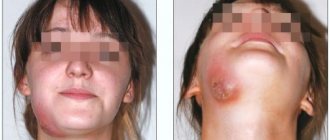Principles of treatment of community-acquired pneumonia in adults
A summary of recommendations without analysis or commentary.
Diagnostics
The diagnosis of community-acquired pneumonia is certain if the patient has radiologically confirmed focal infiltration of the lung tissue and at least two clinical signs from the following: a) acute febrile onset of the disease (T> 38.0°C); b) cough with sputum; c) physical signs (focus of crepitus and/or fine wheezing, hard/bronchial breathing, shortening of percussion sound); d) leukocytosis (>10·109/l) and/or band shift (>10%). In this case, it is necessary to take into account the possibility of known syndrome-like diseases/pathological conditions.
Gram stain and sputum culture
Routine sputum culture and Gram stain are not recommended for adult outpatients with community-acquired pneumonia.
In hospitalized patients, preliminary Gram stain and culture of airway secretions are recommended for adults with CAP that is considered severe (especially in intubated patients) or if CAP meets one of the following conditions:
- The patient is currently receiving empirical treatment for methicillin-resistant Staphylococcus aureus (MRSA) or Pseudomonas aeruginosa.
- there has been a previous infection with MRSA or P. aeruginosa, especially a respiratory tract infection.
- the patient had been hospitalized within the previous 90 days and had received parenteral antibiotics for any reason.
Blood culture
Blood cultures are not recommended in adult outpatients with CAP.
Routine blood cultures are not recommended for hospitalized adult patients with CAP.
Pre-treatment blood cultures are recommended for hospitalized adult patients with CAP that is classified as severe or who meet one of the following conditions:
- Currently undergoing empirical treatment for MRSA or P aeruginosa
- Previous history of MRSA or P aeruginosa infection, especially of the respiratory tract
- Has been hospitalized within the previous 90 days and received parenteral antibiotics for any reason.
Test for Legionella antigen and pneumococcal antigen in urine
Routine urine testing for pneumococcal antigen is not recommended in adults with CAP unless the CAP is severe.
Routine testing of urine for Legionella antigen is not recommended in adults with CAP unless CAP is severe or there is indication of predisposing epidemiological factors (eg, a Legionella outbreak or recent travel).
Testing for Legionella should consist of urinary antigen assessment and collection of lower respiratory secretions for culture on selective media or nucleic acid amplification (PCR diagnostics).
Flu testing
If influenza virus is circulating in the community, testing for influenza in adult patients with CAP is recommended.
Determination of procalcitonin
Empirical antibiotic therapy is recommended for adult patients with a clinical picture of CAP and a radiologically confirmed diagnosis of CAP, regardless of the patient's initial serum procalcitonin level.
Treatment
The decision to hospitalize
The decision to hospitalize adults with CAP should be based primarily on an assessment of the severity of the disease (preferably using the Community-Acquired Pneumonia Severity Index (PSI) for Adults scale).
Direct admission to the intensive care unit is recommended for patients with CAP who have hypotension requiring vasopressor support or respiratory failure requiring mechanical ventilation.
Outpatient antibiotic treatment regimens
Antibiotics recommended for adult patients with CAP who are otherwise healthy:
- Amoxicillin 1 g three times daily OR
- Doxycycline 100 mg twice daily OR
- In areas with <25% pneumococcal macrolide resistance: macrolide (azithromycin 500 mg on day 1 and then 250 mg daily or clarithromycin 500 mg twice daily or clarithromycin extended release 1000 mg daily)
For outpatient adults with CAP who have underlying medical conditions, the following antibiotic regimens are recommended:
- Combination therapy: Amoxicillin/clavulanate 500 mg/125 mg three times daily OR amoxicillin/clavulanate 875 mg/125 mg twice daily OR 2000 mg/125 mg twice daily OR cephalosporin (cefpodoxime 200 mg twice daily or cefuroxime 500 mg twice daily) PLUS
- Macrolide (azithromycin 500 mg on day 1, then 250 mg daily, clarithromycin [500 mg twice daily or extended release 1000 mg once daily]) or doxycycline 100 mg twice daily OR
Inpatient antibiotic treatment regimens
The following empiric treatment regimens are recommended for adult patients with non-severe CAP who do not have MRSA or P. aeruginosa risk factors:
- Combination therapy with a beta-lactam (ampicillin plus sulbactam 1.5–3 g every 6 hours, cefotaxime 1–2 g every 8 hours, ceftriaxone 1–2 g daily or ceftaroline 600 mg every 12 hours) and a macrolide (azithromycin 500 mg daily or clarithromycin 500 mg twice daily) OR
- Monotherapy with respiratory fluoroquinolone (levofloxacin 750 mg per day, moxifloxacin 400 mg per day)
The following regimens are recommended for adult patients with severe CAP without MRSA or P. aeruginosa risk factors:
- Beta-lactam plus macrolide OR
- Beta-lactam plus respiratory fluoroquinolone
The use of antibacterial drugs active against anaerobic microorganisms is not recommended for suspected aspiration pneumonia, unless a lung abscess or empyema is suspected.
Antibacterial therapy with extended-spectrum drugs for MRSA or P. aeruginosa
Empiric antibiotics active against MRSA or P. aeruginosa are recommended for adult patients with CAP only in the presence of locally documented risk factors.
Empirical treatment options for MRSA include vancomycin (15 mg/kg every 12 hours) or linezolid (600 mg every 12 hours).
Empirical treatment options for P. aeruginosa include piperacillin-tazobactam (4.5 g every 6 hours), cefepime (2 g every 8 hours), ceftazidime (2 g every 8 hours), aztreonam (2 g every 8 hours) hours), meropenem (1 g each) 8 hours) or imipenem (500 mg every 6 hours).
Empiric therapy, based on the possibility of MRSA or P. aeruginosa, continues until laboratory culture data are available.
Corticosteroid therapy
Routine administration of corticosteroids is not recommended in adult patients with CAP or severe pneumonia associated with influenza. Their use is approved in patients with refractory septic shock.
Anti-influenza therapy
Anti-influenza treatment (eg, oseltamivir) should be given to all adults with CAP who test positive for influenza.
Antibacterial therapy in patients with influenza
Standard antibacterial treatment should be initially given to adults with clinical and radiological signs of CAP who test positive for influenza.
Duration of treatment
The duration of antibiotic therapy should be based on clinical data in the form of stabilization of the patient's condition and continue for at least 5 days after clinical improvement is achieved.
Criteria for the sufficiency of antibacterial therapy for pneumonia:
- Temperature < 37.5°C
- No intoxication
- No respiratory failure (respiratory rate less than 20 per minute)
- No purulent sputum
- The number of leukocytes in the blood < 10 x 109/L, neutrophils < 80%, juvenile forms < 6%
- No negative dynamics on the radiograph.
X-ray dynamics are observed more slowly compared to the clinical picture, so control chest X-ray cannot serve as a criterion for determining the duration of antibacterial therapy.
Follow-up chest imaging
Routine follow-up testing is not recommended for adult patients with CAP whose symptoms have resolved within 5 to 7 days.
Indications for hospitalization
In accordance with modern approaches to the management of adult patients with community-acquired pneumonia, a significant number of them can be successfully treated at home. In this regard, the following indications for hospitalization are of particular importance:
- Age over 60-65 years.
- The presence of concomitant diseases (chronic bronchitis/chronic obstructive pulmonary disease, bronchiectasis, malignant neoplasms, diabetes mellitus, chronic renal failure, congestive heart failure, chronic alcoholism, drug addiction, nutritional decline, cerebrovascular diseases).
- Hospitalizations (for any reason) that occurred within the last 12 months.
- Physical examination findings: respiratory rate ≥ 30/min; diastolic blood pressure ≤ 60 mm Hg. Art. ; systolic blood pressure <90 mm Hg. Art. ; heart rate ≥ 125/min; body temperature < 35.0°C or ≥ 40.0°C; disturbances of consciousness.
- Laboratory and radiological data: peripheral blood leukocyte count <4.0·109/l or >30.0·109/l; SaO2 < 92% (according to pulse oximetry), PaO2 < 60 mm Hg. Art. and/or PaCO2 > 50 mm Hg. Art. when breathing room air; serum creatinine > 176.7 µmol/l or urea nitrogen > 7.0 mmol/l (urea nitrogen = urea, mmol/l / 2.14); pneumonic infiltration localized in more than one lobe; presence of decay cavity(s); pleural effusion; rapid progression of focal infiltrative changes in the lungs (increase in the size of infiltration > 50% over the next 2 days); hematocrit <30% or hemoglobin <90 g/l; extrapulmonary foci of infection (meningitis, septic arthritis, etc.); sepsis or multiple organ failure, manifested by metabolic acidosis (pH < 7.35), coagulopathy.
- Inability to provide adequate care and follow all medical prescriptions at home.
- Preferences of the patient and/or family members.
Causes
Pneumonia is caused by various microbes (viruses, bacteria, fungi and parasites). However, in most cases the cause is viruses. These include adenoviruses, rhinoviruses, influenza virus (influenza), respiratory syncytial virus (RS virus), coronaviruses, and parainfluenza virus (which can also cause false croup).
Often, pneumonia begins after an upper respiratory tract infection (URTI), and symptoms of pneumonia appear after 2-3 days of a “cold” or sore throat. Sometimes in such cases they say that the infection “went down to the lungs.” Fluid, white blood cells and “all sorts of debris” begin to accumulate in the air spaces of the lungs and block the unobstructed passage of air, complicating gas exchange.
Children with pneumonia caused by bacteria usually become very ill; against the background of complete health, a high fever with chills rises sharply, and shortness of breath appears. Children with pneumonia caused by viruses often have a more gradual onset of acute respiratory viral infections, although wheezing may be more pronounced.
Some symptoms provide important clues about which microorganism is causing pneumonia. For example:
- Pneumonia caused by mycoplasma is very common in older children and adolescents. In addition to the usual symptoms of pneumonia, it causes a severe sore throat, headache and rash.
- In infants, pneumonia caused by chlamydia can cause conjunctivitis and be mild and without fever.
- When pneumonia is caused by whooping cough, the baby may have characteristic, prolonged coughing spells, during which they may turn blue from lack of air or make the classic screaming sound when trying to take a breath (reprise). See video. Fortunately, there is a whooping cough vaccine that protects against both this form of pneumonia and the disease.
- The length of the incubation period (the time interval between infection and the onset of symptoms) varies depending on the organism causing the pneumonia (for example, 4 to 6 days for the RS virus and 18 to 72 hours for the flu).










